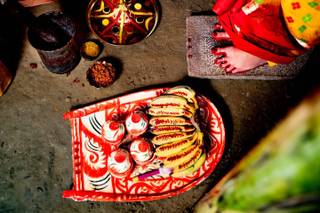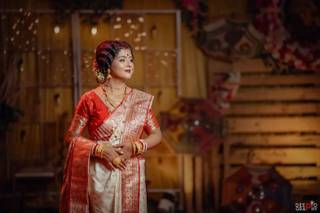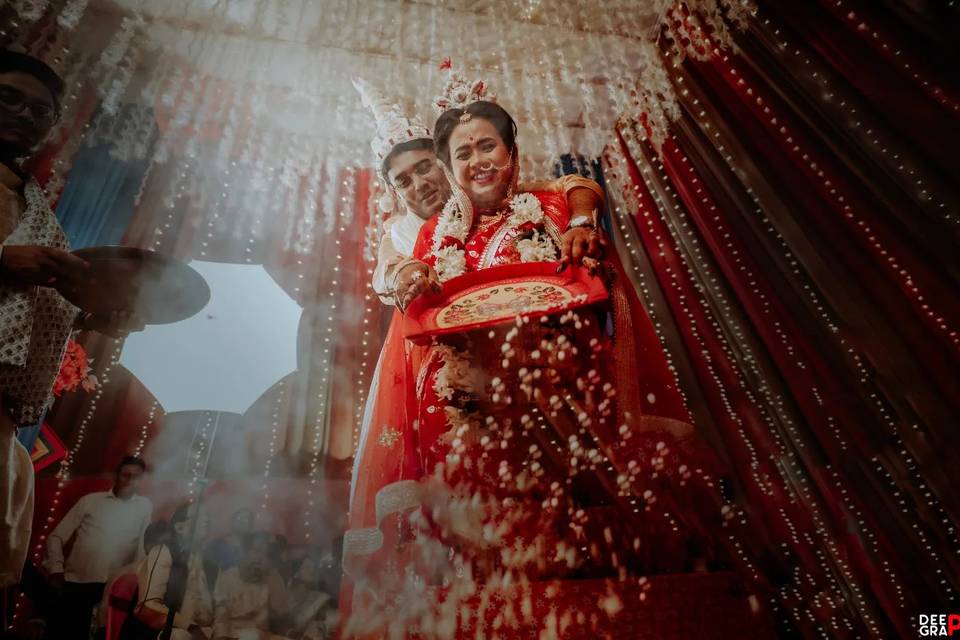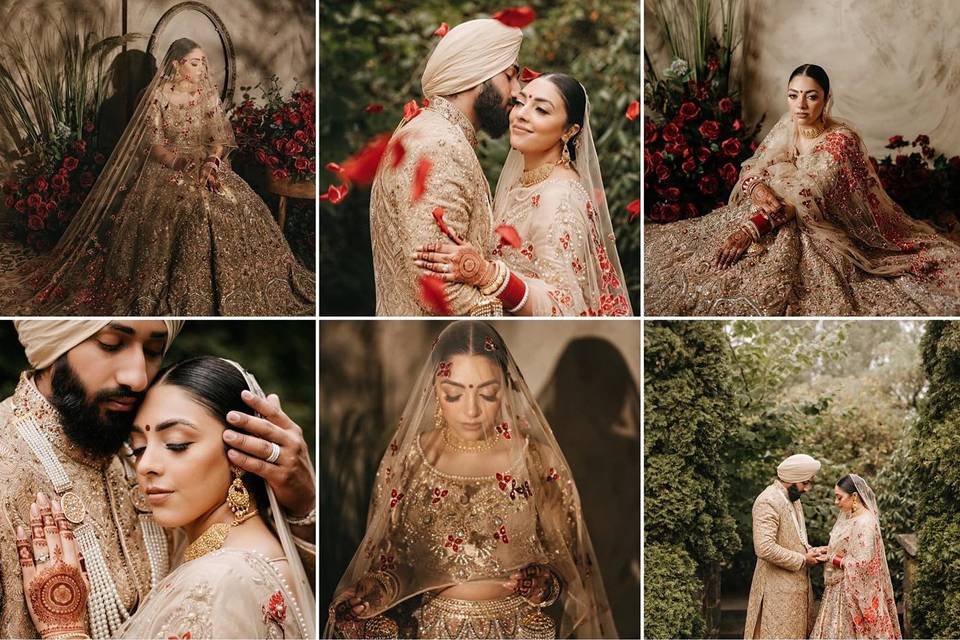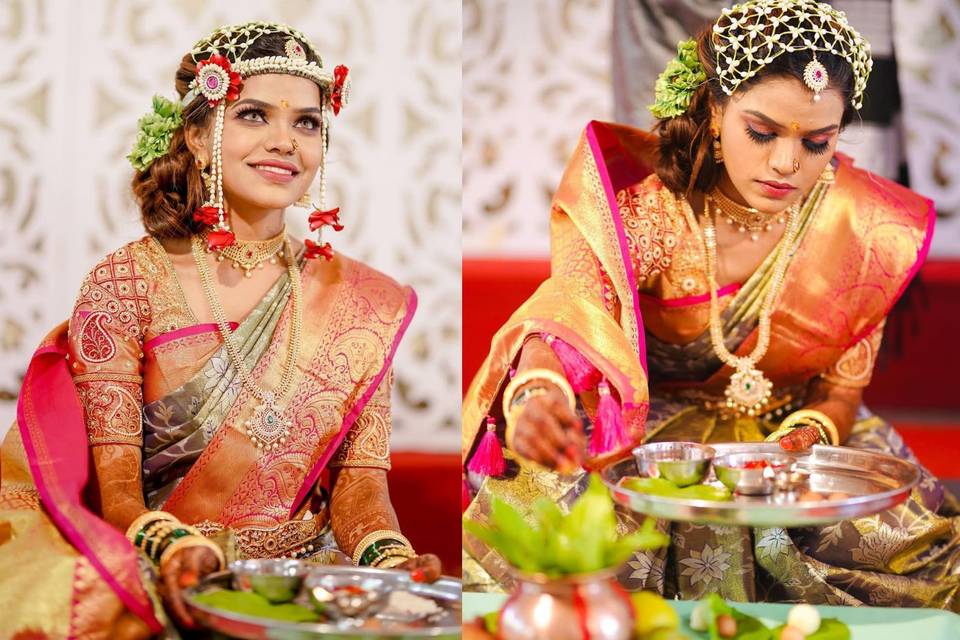Decoding Indian Weddings: The Beautiful Traditions of a Bengali Wedding
If you have only known about Bengali weddings through movies and photographs, here's a closer look at the exotic traditions and rituals followed in a Biye.

Photography: The Deeptography
Every Indian wedding is unique. The musical Jaggo and Dholki ceremonies in a Punjabi wedding, the super elegant Mekhela Chador draped by an Assamese bride, the fun Kashi Yatra in a Kannada wedding or the royal Mahira Dastoor tradition in a Rajput wedding- there are distinctly diverse flavours in an Indian wedding. This is mainly because of the rich Indian cultures that are rooted in traditions. And that's what makes each one of them exclusively alluring. One is sure to fall in love with the beauty of these weddings once one understands the traditions better.
Now, suppose you're going to get married in a typical Bong style or you are invited to your best friend's Biye. In that case, it's a good idea to know a little bit about the traditions because Bengali weddings are not just about draping a red and white saree and eating lots of fish and sweets (even though those are significant parts of Bengali weddings too)!
So, here's an authentic and detailed walk-through of what happens at a typical Bengali wedding. Read on to know what to expect when you visit the next biye bari or marry in a Bengali tradition.
1. Bengali Pre-Wedding Rituals
4. Bengali Post-Wedding Rituals
Bengali Pre-Wedding Rituals
Photography: Srijan Films
There are some quite common and some significantly unique pre-wedding ceremonies in Bengali weddings. So, let's take a detailed look at their names and meanings:
Pati Potro
Pati, specifically a Shital Pati, is a fancy decorative mat used to sit on. It was also used to gather around to decide the marriage date. Both families assemble at the bride's home and fix the date. The groom's family then gifts the bride with auspicious items like sweets, fish, betel leaves, and nuts (Paan-supari).
Fun fact: In older times, the family elders used to write the date, time, and name of the couple, as well as the details of Adan Prodan (dowry/gifts) using sindoor and Haldi using a coin, and sign it along with the names of witnesses. This was considered a respected agreement in Bengali weddings.
Ashirbad
Once the wedding date has been fixed, both families visit each other's homes to bless the bride/groom. Aashirbaad is the Bengali version of the Engagement ceremony or Sagai, except the bride and groom don't exchange rings. Instead, the future in-laws bless them with gold jewellery, clothes, and sweets. Fish, betel leaves, betel nuts, and curd are also customarily gifted as auspicious items in Bengali weddings.
Fun fact: Earlier, the groom's family was always the first to perform Ashirbad, as they were considered to be of a higher stature for accepting the bride.
Ai Buro Bhaat
This Bengali wedding tradition involves feeding the bride and the groom their last bachelor meals in their respective homes. The mother usually cooks the bride/groom's favourite dishes, including all delicious Bengali food items, followed by mouth-watering sweets.
Holud Kota & Dhan Kota
Five, seven, or nine (must be an odd number) married women make Haldi paste out of raw turmeric sticks using grinding stones one day before the wedding. The woman who holds the grinding stone is called the ayo, and the rest have her hands or her elbow while she grinds it. That's called Holud Kota. The same women grind rice powder from scratch (Dhan Kota). This very same turmeric will later be used in the Haldi ceremony.
Fun fact: During the whole process of Holud Kota and Dhan Kota, the women are required to stuff their mouths with betel leaves and betel nuts to stay mute. The most valid reason behind that was to ensure no spit goes into the mixture to keep it pure.
Ganga Nemontron & Kola Gach Nemontron
On the same evening of Holud Kota, the women of the family go to "invite" the Ganges to the wedding—or rather, get permission for the water to be used at the wedding. The women carry trays with bananas, betel leaves, nuts, sindoor, and so on while they go on this procession. After the Ganga has been invited, a Banana tree is invited, too, where an unbloomed plantain leaf is taken from the tree and tied to a Dorpon.
Fun fact: Since Ganga isn't available everywhere, in modern times, women go to any river, lake, or the nearest water reservoir to carry out the ritual of a Bengali wedding.
Dodhi Mongol & Jol Tola
Before sunrise, the mother of the groom and bride lovingly feeds them with curd, puffed rice and sweets with love before they start with all the wedding rituals. That's the last meal they get to eat all day as they need to fast until the wedding is over. Another group of women goes to the Ganges above the river or water reservoir to collect water for the wedding baths. All these must take place before sunrise.
Bridhhi & Nandi Mukh
At the wedding, Pandit performs a Puja dedicated to the seven ancestral generations of the bride, asking for their blessings, along with Lord Narayan. That's precisely a Nandi Mukh at a Bengali wedding. This same Puja is performed at the groom's house, followed by a few steps. A small portion of the previously ground Haldi and rice is used in the puja, and then the groom is bathed in the Ganga water after applying some turmerics. This same Haldi (touched by the groom) is then taken to the bride's house, where she has to use this particular Haldi for her Gaye Holud.
Gaye Holud
After the bride's family receives the groom's turmeric paste along with the wedding Tatto consisting of clothes, sweets, Paan-Supari, and fish, the women of the family apply the same Haldi to the bride. She's then bathed with the holy Ganga water. A Bengali bride usually wears a cotton yellow saree during the Haldi. Some playful Haldi dabbing is carried out amongst family and friends.
Top Wedding Photographers from West Bengal
Bengali Wedding Rituals

Photography: Puspal Chandra Photography
Now let's take a closer look at the main wedding rituals performed at Bengali weddings:
Dorpon to Bor Jatri
Before the groom is sent off to the wedding mandap, his mother hands him the Dorpon (believed to cast off evil), which he is to carry throughout the wedding. The mother then blesses him for his new journey and ties red threads and Tulsi Mala on his neck. Then the Bor Jatri or the Baraat proceeds to the wedding, except for the mother, who's supposed to wait until the bride comes.
Fun Fact: During "ancient times," the mother used to cry vehemently while sending off her son, assuming that from now on, he wouldn't be taken care of well by the new bride.
Chhele Boron to Bostro Daan
Boron in Bengali weddings means welcoming. The bride's mother performs the Chhele Boron (or welcoming the groom) with sweets and water while everyone else plays the holy Conch shell and does Ulludhwani. The bride's father then gives the groom Bostro (new clothes) and Angti (gold ring), which he needs to wear during the wedding.
Fun Fact: Earlier, Bostro daan, the bride's father, had to touch the groom's feet and wash them. Nowadays, they feel the groom's knee with a finger as a formality!
Saat Paak & Shubho Drishti
Saat Paak takes place right after the bride is carried to the wedding mandap while she keeps her face covered with two betel leaves. Usually, the brothers or cousins carry her in a Peerhi or wooden seat (similar to a Butta wedding), and that's when they take seven rounds around the groom. Once this Saat Paak is over, the bride and the groom look at each other three times on Shubho Drishti. This is followed by an exuberant and super fun Mala Bodol or Jaimala ceremony.
Fun Fact: Ages ago, when only arranged marriages existed, the bride and groom never saw each other until Shubho Drishti, which is why this tradition is celebrated with such fervour.
Kanyadan or Sampradan
The groom and the bride sit facing each other, and the bride's father gives her hand to the groom and ties the holy knot using their clothes. This is the Kanyadan ritual in Bengali weddings, also known as Sampradan. There are chanting mantras, representing the groom promising the bride's father to care for his daughter all his life. Once it's done, the couple sits side by side, the bride on the left.
Upto 30% off on Vendor Bookings
Bengali Bashi Biye Rituals
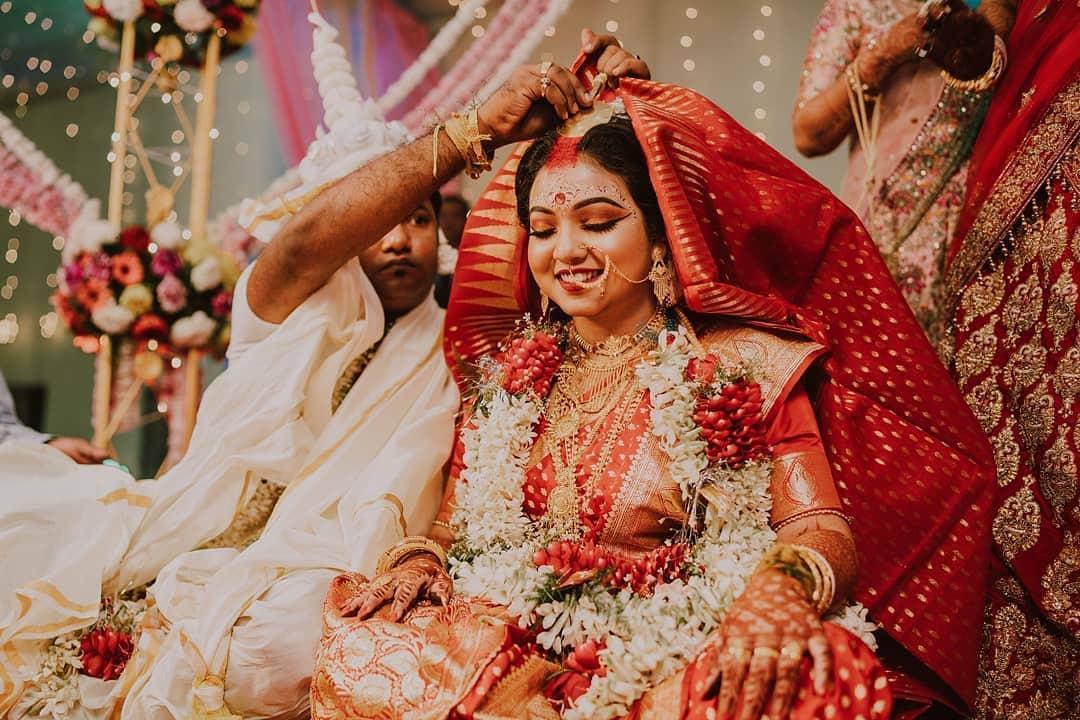

Photography: Two Hearts, Kolkata
Two groups of Bengalis follow slightly different Bashi Biye traditions. Those who have East Bengal ancestry (now Bangladesh) are known as "Bangaal," and those who have their roots in West Bengal are called "Ghoti." The following rituals are followed by both, but with some differences:
Bengali Wedding Games
On all Bengali weddings by Ghoti, Bashi Biye is performed right after the Kanyadaan on the same mandap with a little break. Some play a few wedding games right at the mandap. It is a one-day wedding. However, in a Bangaal Biye, the couple leaves for the bride's house after Kanyadan and plays wedding games with sisters and brothers in the family.
Bashi Biye Snan
This tradition is usually followed only at Bengali weddings. The next morning, the groom and the bride are given baths together while they stand on a Peerhi. After that, the groom changes into clothes that he came to the wedding in, and the bride changes into clothes that are gifted by her in-laws.
Yagnya, Sindoor Daan & Surja Pranam
Yagnya happens in all Bengali weddings, where the wedding Pandit chants mantras. Once Yagnya is complete, the groom applies vermillion to the bride's hair using a ring, a Dorpon, or a small cane box. The third step after Sindoor Daan is Surya Pronam. This happens at a Bangaal wedding, which takes place the following day.
Khoi Fela & Saptapadi
The bride stands before the groom, and her brother fills a tray with puffed rice. The couple then empties the tray into the holy fire. This custom is performed three times. The final step is the holy Saptapadi or the Saat phere. The couple walks around the Yagnya fire seven times while stepping on Paan and pushing grinding stones with their feet.
Bengali Post-Wedding Rituals
Photography: Bibaho Diaries
It's a whole set of fun traditions in a Bengali wedding once the bride enters her new home. Let's take a look:
Bodhu Boron
The groom's mother welcomes the bride by performing Aarti with ghee diyas, flowers, and sweets. She then touches the bride's mouth and ears with honey. She often sits at the gate and makes the bride and groom sit on either lap to shower them with love and show that she accepts them in the house officially. The bride is then welcomed into the house by stepping on a red Aalta and milk solution, leaving footprints on a white cloth aisle. She is often asked to break little clay diyas with her heel instead of the Aalta.
Fun fact: The age-old traditional reason behind the honey-touch was that the mother-in-law expected the bride only to hear and talk sweet things.
Ashirbad & Kaal Ratri
Another round of Ashirbad takes place, during which everyone in the groom's family blesses the newlywed couple with gifts, gold jewellery, and sweets. Once Ashirbad is done, the couple follows a Kaal Ratri, during which they separate from each other for the night and prepare for the bou-bhat the next day.
Bhat Kapod & Bou Bhat
Bhat Kapod in a Bengali wedding is a custom when the groom hands over a tray of a new saree, Sindoor, a plate full of food, and promises to take responsibility for her food and clothing from then on. On the same day, at noon, the bride serves ghee rice to everyone. This is a grand lunch feast where guests from the groom's side are mostly invited and introduced formally to the bride.
Fun fact: In olden times, the absence of electricity was the reason why Bou-Bhat was organized as a lunch instead of a dinner. However, millennials have also hosted Bou-Bhat along with the official reception party at night.
Ashtamangala
On the eighth day from the day of the wedding, the couple visits the bride's family, where they spend a day or two. That's when the knot (tied at the beginning of the wedding) has to be undone, officially marking the end of the wedding. This is often also called the Doshomangala for couples who observe this ceremony on the 10th day's wedding day.
Top Bridal Makeup Artists Near You
A Bengali wedding is traditionally a long and detailed affair regarding rituals and customs. However, things have been simplified and shortened over time for everyone's convenience. Certain traditions have been discontinued, and some have been changed to keep up with the times. For instance, at some weddings, the bride and groom take oaths of responsibility for "Bhat Kapod" to each other. This has become a rather fun custom! Most families now prefer to do the Bashi Biye on the same night rather than the next day. But more or less, these are the traditional Bengali wedding rituals that are followed everywhere with slight variation.
Decoding Indian Weddings with WeddingWire India:
2. Decoding Hindu Punjabi Weddings




























